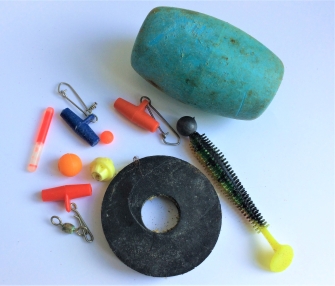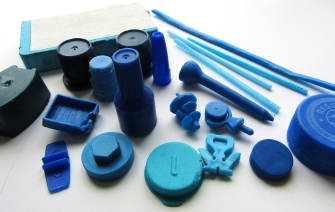

Pieces of plastic
Small plastic items prove the point that throwing or flushing something away doesn't always mean that it has gone. Things that turn up on our beaches have been flushed down the loo, thrown off boats, washed down from fields and roads into our rivers or sewer system, flown in by air (balloons) or simply dropped on our beaches. As plastics will not biodegrade in our lifetimes (or our children's lifetimes), they will hang around in our seas and on our beaches until we physically pick them up and throw them away.
There are more plastic items in our Rubbish Gallery.
What's wrong with plastics?
The pieces don't interfere with shipping, or surfing or anything else we want to do so wy are they a problem?
The problem is that sea birds and other marine life mistake pieces of plastic for food and animals like seals, dolphins and turtles get tangled in ropes and carrier bags. The more we can get out of the water, the better for our wildlife.
When you pick up litter, tag #2minutebeachclean. Visit the 2 minute beach clean website for more details.

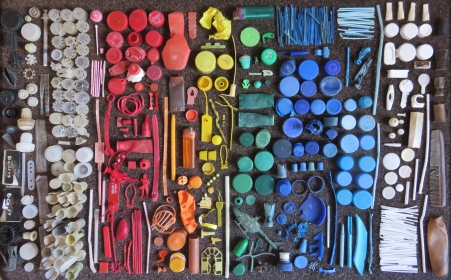
Here are a few of those items that just seem to keep on turning up and some of the reasons why they do:
Vulcanite stoppers
These were first made from super-heated rubber in the late 19th century and were the first bottle stoppers which had a screw fitting.
Stoppers can be plain, may have brand names or patterns and symbols it is trickier to interpret, like these two pictured here.
More on these stoppers, on this page.
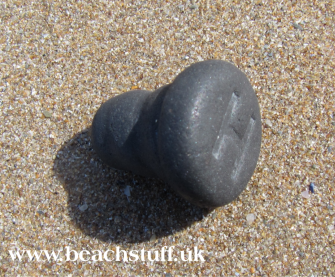
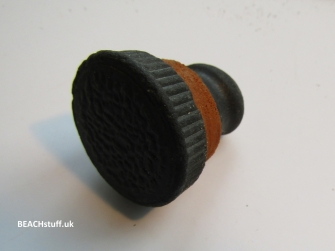
Despite its lengthy time in the sea, this stopper still has its orange rubber collar to better seal the bottle.
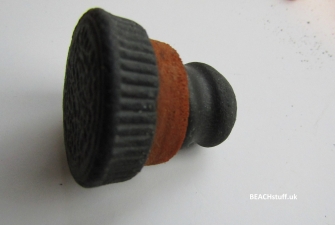
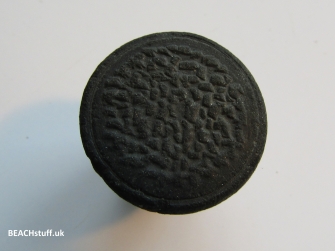
LOOKING FOR FISHING/ANGLING FINDS?
There are so many of them, they are on a page of their own now. Cast yourselves over to this page to see them.
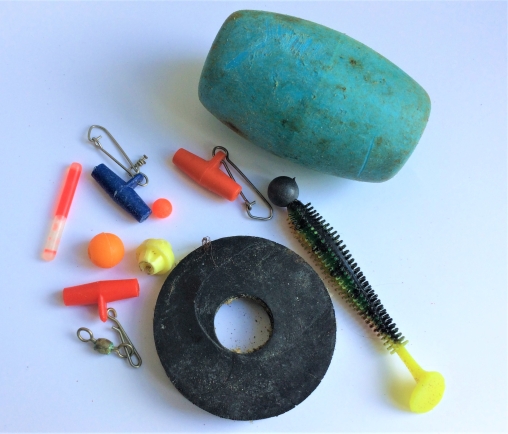
Nurdles
These tiny, largely circular pieces of plastic often litter our strandlines even when there is no sign of larger rubbish. They are only a few millimetres wide and a bi-product of plastic manufacture which somehow find their way into the water. Once there, birds can mistake them for food with dire conseqences.
As a slight variation on a theme, these black - less smooth-looking - pieces (photographed below) have been showing up lately. They're still only 3 or 4 mm wide. Have a look at 'The Anatomy of the Nurdle' for more information.

Lego pieces
In 1997, nearly five million bits of Lego fell into the sea when a huge wave hit the container ship Tokio Express in the Atlantic, washing 62 containers overboard.
Thousands of very specific Lego pieces have been washing up in the South West. The ones pictured are a snorkelling fin, pirate's cutlass, life jacket, flower, seaweed and scuba equipment.
Scroll to the foot of the page for more toys.
Cotton Ear Bud sticks
Blue, white pink, these little plastic sticks end up on our beaches in their thousands - usually missing their cotton ends. Amazingly, people flush them down their toilets when they've used them and they can then get missed by our water treatment plants and end up back in our water courses and seas.
In October 2020, in part because of pressure from beachcombers, the English government joined the Scottish, in banning these along with plastic straws and plastic stirrers.
Yep, you're not in Rymans, but you can still pick up your stationery needs on the beach (although they may not work too well now). It is thought that a shipment of 1000s of pink and blue ink cartridges was lost in a storm off Land's End and these have been washing up on European beaches since early 2016. Hewlett Packard has set up a fund to help organisations clean up beaches.
The orange piece is the top seal of the print cartridge.
UPDATE: I am still finding these washed up on Nort Devon beaches in autumn 2020.
Plastic plants
I have found many small pieces of plastic plants on beaches with no idea why. Then the thought struck me that mabe they are from home aquariums. But would people really throw their old aquarium water into the sea? Plants and all? And is Goldie dumped too? I'd love to hear your theories about the plastic plants.
Shotgun shot casings
Some countries carry out shoots of marine birds, for sport or pest control. The plastic casings of the bullets float in our seas for generations. Occasionally, a bullet casing will have branding on it, like the Rottweil bullet below made by a German hunting ammunition company. Others are unidentifiable.
See also - metal bullets
For more information on our sea birds, have a look at our page here: sea birds
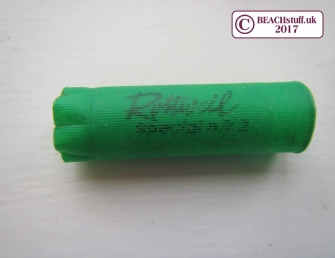
Firework innards
This clear plastic tube is longer and thinner than the bullet casings above. It is in fact the inside of a firework and they are generally blackened by the explosion they have been in. Lots of bits and pieces of fireworks end up on the beach.
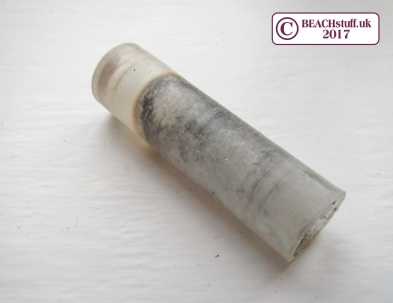
Plastic fish
It is perhaps ironic that we end up with plastic fish on our beaches. These are, in fact, nothing to do with the sea, but are plastic soy sauce bottles. This one is missing its cap.
Want to see some real fish? Visit this page.
Smarties lids
There are generally loads of different lids and caps to be found on the strandline. The best, in my humble opinion, are Smarties lids. Has anyone ever managed to collect a full alphabet?
Each Smarties lid contains clues about its history. We can identify some as being 50+ years old which is amazing for a brittle little bit of plastic bobbing about on the ocean. Visit our page on the history of lids to find out how old your lid is.
UPDATE
It is now three years since I first wrote this page and I am now the proud possessor of a nearly complete alphabet of Smarties lids!!
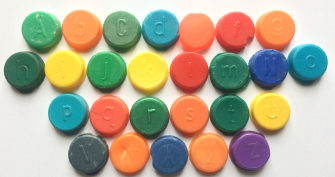
Sadly, I am still short of an E (there's a blank lid in its place). Those of you who are eagle-eyed will notice a photo of an E above. So where is it?? I have lost my lid!! - which has almost caused me to lose my marbles!! Ah well. Will update again as soon as I find an E...
Curler's pick
I love this. I can remember my grandma putting in her plastic curlers and using picks just like this one to hold each curler in place. I wonder just how long this pick has been floating around. Since the 1960s?
A few months after finding my first pick, in pretty much the same spot, I found a pink pick and then the curler itself (below).

Sewerage rings
These types of plastic ring are thought to be the sort of media used in water treatment plants. I have talked to people in water companies who say that there is no way the media they use in their treatment plants could end up in the sea. Some large ships have water treatment plants on board and perhaps this is the route taken by this sort of thing to get into the sea.
These black ones sudddenly became a much more common find in 2019 in north Cornwall and north Devon particularly. It is thought that wa shipment was lost off the coast of the southern tip of Cornwall during a storm.

Plastic Bungs
It is not unusal to find these small bungs, usually in blue or red. After a long search, I finallydiscovered that they are brewers' bungs. They are in small kegs used as part of the brewing process which are then washed out when the beer is moved on. It seems that some bungs are washed into the drainage system.
Pens
Pens are often found on the strandline but it does seem that more of this type of Barclays pen is around more than other branded pens. Are there simply more of them to be lost, or was a container of them lost at sea at some point? Or is it just my imagination...?
Tags
These plastic tags and ties are used to seal anything to prevent it being tampered with. Sometimes, the writing on the tag wil give an indication of its use, otherwise there may only be a number or, perhaps, nothing at all.
Kreuger Biofilm Chip
possible Hooksett disk
In 2011, a wastewater treatment plant in Hooksett, in Merrimack County, New Hampshire, US, suffered a massive loss of Kreuger Biofilm chips which were used to grow bacteria as part of the sewage treatment process. More details can be seen from this news item.
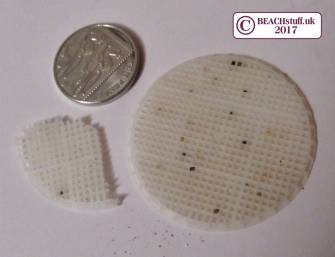
Orange rubber rings
These orange, squishy rings are about the size of Cheerios but, sadly, the comparison ends there. Far from being a lovely breakfast, these rings are used in the process of docking lambs' tails as they help stop the blood flow.
One of the items we find on the beach that we assume comes from farming land in the vicinity. Perhaps items like this are washed into the sea via streams running through the fields.
Six pack rings
These tough plastic loops used to hold cans together sometimes end up in our seas - with potentially disastrous consquences for wildlife. Turtles and sea birds get caught in the loops, other creatures swallow the plastic. And these plastics take lifetimes to biodegrade. Perhaps there is an alternative. This news feature describes six pack rings which are not only biodegradable but marine life can eat them.
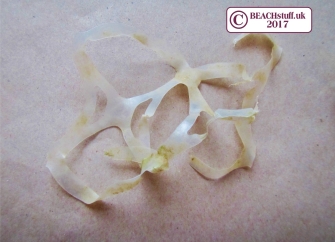
How do bits and pieces of building equipment end up on the beach?
Caps for roofing sheet screws
I find these plastic covers in a range of sizes and in a range of colours, mostly commonly in around 50 shades of grey. Are they getting washed/blown off roofs and then washed into our storm sewers? Is that how they up on our beaches? Perhaps people should be putting a dab of glue on them to ensure they stay put.

Plastic nut covers
Similar to the roofing screw covers above, these are designed to protect metal nuts and bolts.
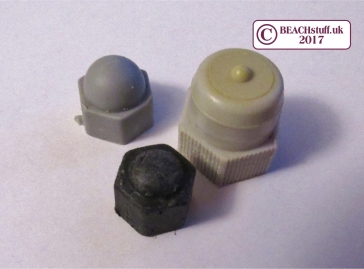
Tile spacers
Tile spacers turn up on the beach with some regularity. But how do they get from our walls to the beaches?
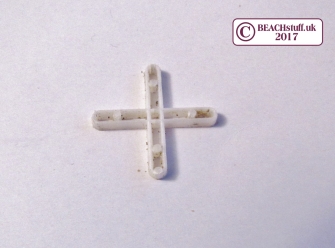
Rawl plugs
These little plugs, used for holding screws in the wall, are perfect for floating on the ocean. Lightweight but sturdy plastic, they will be with us for generations. However, if you do happen to pick them up, they are very handy to have in your toolbox - most still being usable.
Plastic shims
Known as shims or horseshoe packers, these are used in those jobs where spacing is important (like fitting a door or window). Each is numbered to depict the sizing it will give you.
Fishing, Crabbing and Lobstering items
Many of the items (like those pictured below) washed up from fishing activities are also made of plastic. I've got a whole page of the stuff here.
 |
 |
 |
 |
 |
 |
So many toys...
Mastermind
I used to spend hours playing this as a kid. These pieces of plastic take me right back to those frustrating days of trying to guess precisely what colour combination was behind the little screen. Grrr.
Jacks
Here's a game that has been played for donkeys' years. No wonder it's worn out.
Cap gun caps
It's amazing how often you can find these on the beach - far more often than you ever see a child playing with a cap gun...

Toy gun 'bullets'
These tiny flourescent balls come with toy plastic guns. Once they have been shot onto the sand, they are lost forever - until some beachcomber comes along and picks them up. Compare these with the flourescent beads used in fishing.

Soldiering on
I am not sure that I have ever witnessed anyone ever playing with toy soldiers on the beach. Ever. And yet I find them regularly.
The truth is, you never know who you are going to find on the beach...
We can rebuild her
Sometimes, my sentimental side gets the better of me. When I found this rabbit beached after a storm, I put out a social media appeal to see if I could trace an owner and I set about repairing some of the storm damage. Sadly, I never found the owner but Rabbit is here waiting, just in case....
And what about these? About a centimetre long, always in red it seems. Are they the feet of square penguins?
Any ideas to the usual email address.
UPDATE: It's 2025 and I still have no idea what these things are. And they still keep showing up!
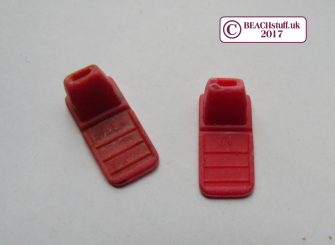
LOOKING FOR FISHING/ANGLING FINDS?
There are so many of them, they are on a page of their own now. Cast yourselves over to this page to see them.
